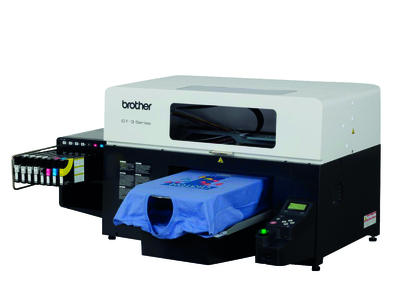Direct to garment printing in action
The hefty costs for minimum runs that characterised garment printing using screen printing processes, not to mention the long set up and lead times involved, are being put in the shade by digital direct to garment systems such as those sold by J & B Sewing.
Direct to garment printing is the fastest growing sector for garment decoration and it is very easy to see why. The technology, first introduced in the early 2000s, totally revolutionised the way garments, particularly t-shirts were produced.
Previously, producing a full colour printed t-shirt required a huge level of skill to initially create the image, then produce colour separations, and from these produce the screens for the screenprinting process. Once all this was done, and to have a hope of recouping the costs of time and materials used in the process, a screen printer would be looking for orders of 100 to 200 as a minimum starting point.
With direct to garment printing, once an image has been produced it is a simple case of taking it into the software supplied with the printer, setting ink levels, loading a t-shirt and printing. Between one and three minutes later the t-shirt is printed and, following a short heat press to dry the ink, is ready to wear, or send to the client for approval. There are no demands to produce a minimum quantity as there really is no set-up time. If the client is not happy with the sample, it is a very easy process to change any aspect of the image, size, shape, colour etc and reprint. These changes literally take seconds.
The inks that are used in these printers are all water based and there is no need for special ventilation as there are no solvents involved. This means it is possible to set up in a spare room at home whilst initially building the business.
As the technology has advanced, printer speeds have increased, and it is not unusual to be able to produce at rates up to 50 plus garments per hour.
Ink costs are higher than screen printing, but with the time savings that are made, it is around 30 times the number of screens being used before screen printing becomes cheaper and quicker than direct to garment printing.
A further benefit is that inventories are kept to a minimum as it is easy to print on demand, and if a design does not sell then you will not be left with a large stock of printed but unwanted garments.
It is also very easy to change the size of a design with no set up considerations. If a customer wants a child’s shirt with a similar design as an adult shirt then the image can simply be reduced by percentage and printed.
Ideally suited to a web based business, and with many software manufacturers now creating web based shop solutions it is very easy to have a business up and running with professional branding that can operate from a spare bedroom.
Techniques are being developed to print on glass, wood, canvas, and other alternative media, and finishes with coloured foils enhance the marketability of direct to garment output.





